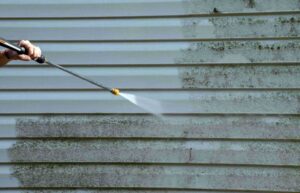Everything You Need to Know for DIY Roof Moss Removal
Some homeowners and business owners find moss to be a beautiful addition around the home, but it’s only nice when it stays on tree bases and stones. When moss gets on the roof, it will often develop into a serious and costly problem that could result in structural damage to your home. Keep reading for our DIY guide on roof moss removal.
In this article we cover:
- The Danger Moss Poses to Your Home
- Do-It-Yourself Moss Removal
- What NOT to do with DIY Roof Moss Removal
- How to Prevent Moss on the Roof
- Why You Should Hire The Professionals
The Danger Moss Poses to Your Home
The perfect surface for moss does not receive much sunlight and is in a damp, cooler environment. For some people’s homes, their rooftop is a perfect environment. When moss starts to grow, it’s barely noticeable and looks harmless, but can become detrimental to your roof if left untreated.
A thick layer of moss will develop and expand between and under shingles. Moss is like a sponge and when it grows under shingles, moisture is able to seep into the roofing felt and structure beneath—a part of your home that’s meant to stay dry. This moisture leads to rotting, which endangers the structure of your home and sometimes results in a whole roof replacement.
How Clogged Gutters Factor In
Clogged gutters are more than just growing plants or leaves poking out from the roofline. Overflowing and clogged gutters lead to sitting water on a roof, which can lead to moss growth. As you prepare to learn more about how to remove moss from your roof, consider cleaning your gutters as well as a preventative measure.
Do-It-Yourself Moss Removal
Removing moss from your roof is quite a chore, but it can save money and ultimately prevent the need for major (and costly) home repairs in the future. But, it isn’t a matter of simply blending dish detergent and water in a bucket and grabbing a brush. There are different methods for moss removal and things you should consider with each one.
Use A Scrubber
Many homeowners and business owners simply grab a scrub brush or scrapper and begin working on freeing their shingles from moss. Many roofing materials, such as shingles, have a coating designed to provide protection from the elements. Being overzealous in scrubbing, or using the wrong tool for it, may damage your roof and potentially void your roof’s warranty.
If you have to use a scrubber, use a softer scrub brush and work slowly from the top of the roof and down. Avoid lifting the shingles and be careful not to apply too much pressure to prevent damage.
With scrubbing, you can inadvertently encourage more moss on your roof. The spores from the moss you are removing can spread and move onto other parts of the roof, developing quickly into new growth. Prevent this by rinsing your roof and using a chemical roof moss killer.
Make Your Own Bleach and Water Solution
This 50/50 combination effectively kills moss—and every other plant it touches—on your roof and in your gutters. If the moss on your roof is still a thin layer, you may be able to use this solution to remove it without scrubbing. If not, though, it is still important to kill spores that have moved onto new places on your roof. For a natural mixture, substitute vinegar for bleach.
Because this solution can kill other plants and damage some housing materials, you will need to protect the ground below from run-off. You can wet plants to help protect them, or use disposable plastic drop cloths to cover the landscaping and walkways.
Baking Soda
In addition to a vinegar-water solution, you can also use baking soda as an all-natural alternative. Mix 3 tablespoons of baking soda per one liter of water and spray it on your roof when the forecast is calling for dry, warm weather. After a few days, the moss should be dried up and can be brushed off.
Spray a Liquid Roof Moss Killer
Commercial products can be purchased at most, if not all, hardware stores and will attach to your garden hose. The chemicals blend with the water as you spray it onto the roof, typically from the safety of the ground for one-story homes and when the roof is dry. When using liquid solutions for removing moss from your roof it can be easy to lose track of progress, leaving parts of the roof untreated. Additionally, it will still be necessary to remove the dead moss later.
Apply a Dry Roof Moss Killer
With dry powder moss killers, several lines of powder are applied parallel to the ridge of the roof. Rain then mixes with the powder and runs into the gutters, killing the moss along the way. This process takes about a week and relies on frequent rain and low winds to be effective. Using this method for roof moss removal has the added benefit of evaluating how bad moss growth is and a cursory assessment of any damage it has done.
Gentle Washing
Use a garden hose to clear away residual spores or chemicals that may lead to damage later. Be sure to use a standard spray attachment to prevent damage, and be mindful of where errant water may fall so that it doesn’t become a safety hazard.
What NOT to do with DIY Roof Moss Removal
While this guide is designed to tell you how to remove moss from your roof, there are a few things that you shouldn’t do. Here are the don’ts in moss removal:
Don’t Pressure Wash
Pressure washing poses a serious risk to your roof due to the damage it can cause. The high PSI of pressure washing—and even soft washing—can dislodge shingles, remove the protective coating, or otherwise damage them. That damage can often void your roof’s warranty.
Don’t Use Laundry Detergent
Or any cleaner not designed for this purpose. The result will be a wave of suds cascading from the rooftop onto your landscaping, walkways, and drive. As a community in British Columbia found out, the more soap, the more suds. This situation is a hassle to clean up and will wreak havoc on plants and wildlife.
How to Prevent Moss on the Roof
There are some preventative measures that you can take to minimize the risk of moss developing on your roof.
Rinse Your Roof
Once or twice a year, rinse your roof using your water hose to remove debris and other organic matter that might encourage moss growth.
Remove Shade
One way to stop moss before it starts is by removing one factor that facilitates its growth: shade. Trim back trees to allow sun exposure as well as prevent decaying leaves and debris from falling on your roof.
Install Anti-Moss Strips
Copper and zinc combat moss growth, so many homeowners and business owners install these strips on the roof to help prevent growth. It’s important to consult with your home insurance company first, though, as this may void your roof’s warranty.
Regular Gutter Cleaning
Prevent moss on your roof by making sure water can’t pool on your roof. As we stated, clogged gutters lead to water build-up, and when combined with a shady spot, it’s a perfect mix for moss. Cleaning your gutters is essential to your roof, and it isn’t just because of moss. From insects to water damage, clogged gutters are a threat to your home and your health.
Why You Should Hire The Professionals
In the case of gutter cleaning, it’s a good idea to use a professional service. Many different tools are required to get the job done right without damaging your gutters or roof. Hiring a professional service to clean the gutters and exterior of your home or business is an investment in your property’s curve appeal, your safety (it can be dangerous), and is just a more convenient route for home maintenance.
Get your home summer-ready with LaborPanes. Have the exterior needs of your home taken care of by licensed, trained experts that can clean your home without damaging it. Get in touch today for a free quote!
Frequently Asked Questions about Roof Moss Removal
How do I clean moss off my roof?
There are a few different techniques to do this, but ultimately it comes down to selecting the right cleaner that works for you and whether or not scrubbing is necessary.
Should you remove moss from your roof?
Yes, moss can lead to structural damage to your property so it’s important to remove it as soon as possible.
What home remedy kills moss on a roof?
A 50/50 mix of vinegar and water, or bleach and water, can kill moss and its spores.
Does baking soda kill moss on roofs?
Yes, it does. Mix 3 tablespoons of baking soda per one liter of water and spray it on your roof when the forecast is calling for dry, warm weather. After a few days, the moss should be dried up and can be brushed off.


